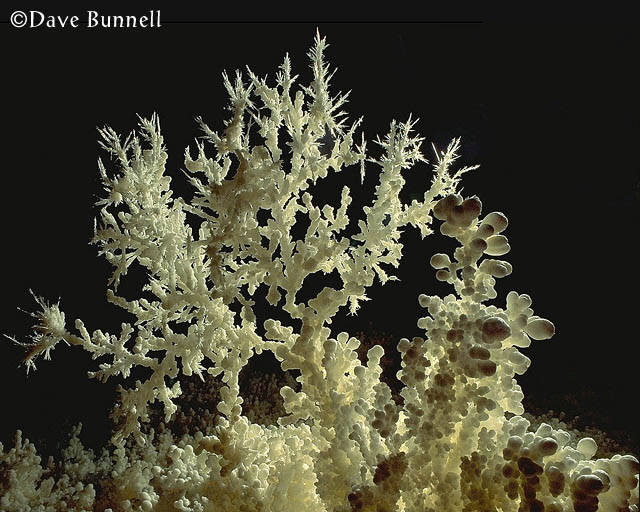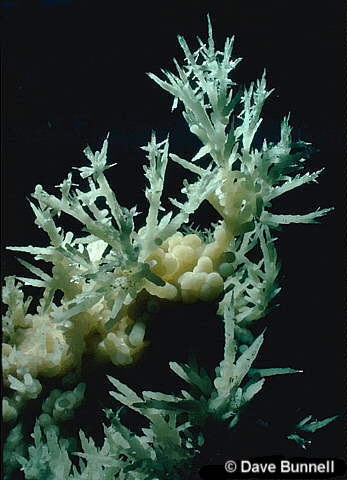
| Aragonite, like calcite, is made up of calcium carbonate (CaCO3). It differs from calcite, however, in its internal crystalline structure. Dense masses of tiny aragonite crystals can be difficult to distinguish from calcite, but when the crystals are large, they reveal a distinctive external form, or crystal habit. Aragonite crystals are long and needle-like (acicular), whereas those of calcite tend to be stubby or dog-tooth-like (often rhombohedral, but calcite is a master of disguises--easily the most capricious of minerals when it comes to outward appearances). Bushes of acicular aragonite crystals are also known as frostwork, as in the top photo. If you simply can't resist the urge to ire some student of mineralogy, remind them that aragonite and calcite are happy bedfellows in many caves. They'll stammer, stab at phase diagrams like they were holy scripture, and insist that aragonite just plain isn't stable at such low pressures and temperatures. But even as they speak, cave aragonite grows on, seemingly in open defiance of the laws of chemistry. Its secret: a loophole clause known as "magnesium-poisoning". "Magnesium-poisoning" is the name given by carbonate geologist Robert Folk to the phenomenon by which certain solutions supersaturated with respect to calcite are inhibited from actually precipitating calcite due to high concentrations of magnesium. It seems that the magnesium ion somehow interferes with the lateral growth of calcite crystals. As calcite deposition is suppressed throughout evaporation or degassing of carbon dioxide, the higher supersaturation concentration of aragonite is eventually reached. The lengthwise growth of aragonite crystals is not inhibited by magnesium; they grow freely in an environment that would otherwise be foreign to them. Due to its dependence on the magnesium ion, aragonite is typically the product of evaporation. Evaporation drives the concentrations of all ionic species up. As calcium is lost to calcite precipitation, the magnesium-to-calcium ratio increases to the point at which calcite growth is inhibited (about 2.9:1), and aragonite is thenceforth deposited. A common progression from calcite to aragonite due to evaporative enrichment is seen the bottom photo, where a nodular mass of calcite popcorn is tipped by sprays of aragonite needles. |
![]()


![]()
| Back to: | |
 |
Created: June 19, 1995 Last Updated: January 16, 1996 Author: Djuna Bewley |